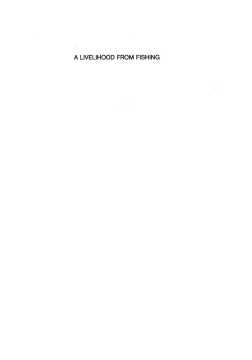
Additional Information
Book Details
Abstract
The global fishing crisis has been described as the world's worst ecological disaster. Official sources describe the world's main fishing grounds as being fished at or above their limits; 70 per cent of fish stocks are regarded as fully exploited, over-exploited, depleted or recovering. But how many of us really understand the social and environmental impacts of the global trade in luxury fish products? Artificially coloured farmed shrimps from South Asia create exotic meals and huge profits, but cause major social and environmental disruptions. What are the social and environmental implications of feeding one-third of the world's fish catch to cattle, pigs, poultry and other fish? While, quite literally, nations and fishworkers go to war to defend access rights, and environmental organizations and fishworkers clash over policies, many of us do not know the difference between a trawl- and a drift-net. This book is the result of reflection, meetings and discussions since 1984 when the FAO organized the World Conference on Fisheries Management and Development and is also the fruit of close ties with fishworker organizations in both North and South. It contains a broad overview of fisheries (values and quantities of species caught), and describes for the general reader the social and nutritional issues raised by the modernization of fisheries worldwide. It aims to inform all who are interested in the protection of the marine environment and the plight of workers in the fisheries sector.
Table of Contents
| Section Title | Page | Action | Price |
|---|---|---|---|
| Title Page | iii | ||
| Copyright Page | iv | ||
| Table of Contents | vii | ||
| Foreword | ix | ||
| Preface | x | ||
| Sections 1: Fisheries Today | 1 | ||
| Fish is an Essential Food | 3 | ||
| Consumption Levels are Unequal | 5 | ||
| The Productivity of Oceans Varies | 7 | ||
| Increasing Production is not enough | 9 | ||
| Fish is Fed to Livestock | 11 | ||
| Japan is now a Shaky Giant | 13 | ||
| Canada's West-Coast Fishery | 15 | ||
| Opportunities from the Sea | 17 | ||
| Threats from the Land | 19 | ||
| China Emerges as a Fishing Power | 21 | ||
| In the South, Fishing is on the Rise | 23 | ||
| Aquaculture Gains in Stature | 25 | ||
| Intensive Aquaculture Becomes the Modem-day Gold Rush | 27 | ||
| The North Imports More | 29 | ||
| The South Exports More | 31 | ||
| France Feeds off the South | 33 | ||
| Artisanal Fishing Creates Jobs | 35 | ||
| Artisanal Fishworkers are Growing in Number | 37 | ||
| The Role of Women is Ignored | 39 | ||
| Quotas and Fisheries Mismanagement in the North | 41 | ||
| Sections 2: Key Issues | 43 | ||
| Globalization is Spreading | 45 | ||
| Multinationals Play a Powerful Role | 47 | ||
| Fishing Helps Repay Third World Debt | 49 | ||
| Too Much Capital Invested in Global Fisheries | 51 | ||
| Scarce and Highly Prized Fishery Resources | 53 | ||
| India is Caught between the Devil and the Deep Blue Sea | 55 | ||
| Post-Harvest Losses are Considerable | 57 | ||
| Coastal Regions under Threat | 59 | ||
| Mangroves are in Danger | 61 | ||
| The Growth of Sport Fishing | 63 | ||
| Exclusive Economic Zones Take Effect | 65 | ||
| Environmental Groups Turn\r on the Pressure | 67 | ||
| Environmental Laws: Eco-Protection or Barriers to Trade? | 69 | ||
| Conflicts Erupt More and More Frequently | 71 | ||
| Blue Europe is a Huge Market | 73 | ||
| Fisheries Agreements Have a Commercial Bias | 75 | ||
| Aquaculture Competes in the Market for Fish | 77 | ||
| Individual Transferable Quotas (ITQs) | 79 | ||
| Sections 3: What needs to be done | 81 | ||
| Artisanal Fishworkers Must be organized | 83 | ||
| The Need for International Co-Operation | 85 | ||
| Women's Roles must be Recognized | 87 | ||
| The Environment must be Protected | 89 | ||
| Highly Complex Systems must be Managed Well | 91 | ||
| Management Objectives should be Rationalized | 93 | ||
| Participatory Management | 95 | ||
| Make the Best of Fish as Food | 97 | ||
| Choose Environmentally Sound and Selective Fishing Techniques | 99 | ||
| Kerala Bans Trawling | 101 | ||
| Limit by-Catches | 103 | ||
| Promote Extensive Aquaculture | 105 | ||
| Regulate the Markets | 107 | ||
| How free and fair is the free Market? | 109 | ||
| Review Fisheries Agreements | 111 | ||
| Implement a Code of Conduct for Responsible Fisheries | 113 | ||
| Glossary | 115 | ||
| Bibliography | 122 |
